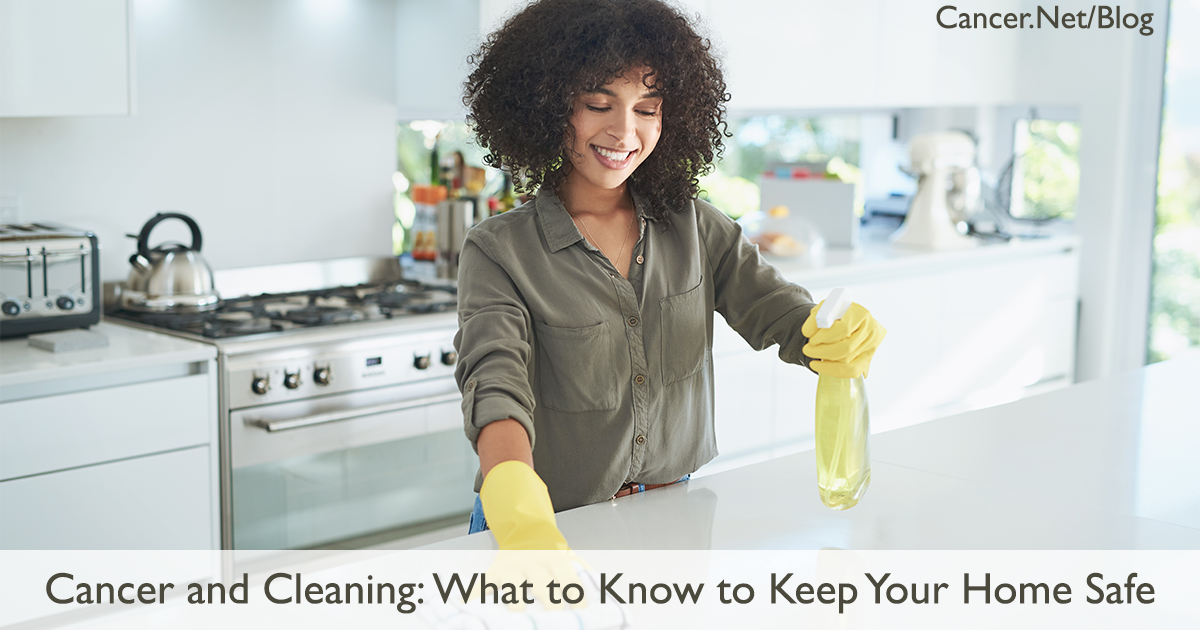
Cleaning your home is often an unnoticed and uncelebrated task. However, a clean home can help prevent the spread of infection. That is good for everyone under your roof, but it is particularly important when you are caring for someone with cancer.
As a caregiver, you have a lot on your plate already. Make the most of your time by focusing on cleaning key areas of your house. Here are some things to consider about cleaning your home while caring for someone with cancer. And, be sure to talk with the cancer care team as well to see if there are specific recommendations on cleaning or other home care guidance based on your loved one’s needs and treatment plan.
Why a clean home is important for someone with cancer and their caregivers
Your home is your sanctuary. It is a place where your loved one can rest and heal. Keeping your home clean can help maintain a sense of control during an uncertain time. As mentioned above, it also prevents the spread of illnesses, which is especially important for people with cancer.
Chemotherapy, radiation therapy, and other treatments can weaken the body’s immune system. Certain cancers that spread to your bones can weaken your immune system, too. Therefore, people with cancer may be more susceptible to illness and infection. It may be hard to fight off things like a cold, the flu, or food poisoning.
Cleaning can also help protect everyone in the home from the toxicity of certain medications your loved one may be receiving, such as chemotherapy, which can stay in bodily fluids for up to 7 days. Because of that, you’ll want to take special care when cleaning places like the toilet or when washing laundry (see more below). Ask the doctor or another member of the health care team about any special precautions needed for each of the medications prescribed for your loved one.
First focus area: your hands
You probably don’t consider your hands as part of your home. Yet, your hands touch almost everything in your house. From the moment you walk in the door, your hands can bring germs from the outside into your home. You can spread them around by touching shared items in the home, such as countertops, the remote control, screens, sink and toilet handles, and appliances.
That’s why it’s important to wash your hands with warm, soapy water frequently. Ask children, visitors, and home health care workers to do the same. You should also try to wipe down high-touch areas regularly, like your phone, tablets, remote controls, doorknobs, and light switches, which can be easy to forget. Most of the time, you can use regular soap and water and/or household disinfecting wipes. Follow the instructions on wipes, as some require the surface to stay wet for a full 10 minutes. Also, check out the instructions for the best way to clean your specific electronics.
Small steps to save time
It might sound obvious, but the quickest way to clean is from top to bottom in a room. If you mop the floor before you’ve cleaned the counters, you may end up needing to mop again.
Try to clean and organize as you go. Cleaning up right after a greasy dinner is easier than cleaning caked-on grease the next day. Organizing and decluttering will make cleaning tasks quicker because you won’t have to move as many items each time.
Keep all your cleaning supplies in one area so you can grab and go when you have the time. Don’t feel like you have to clean the entire house each time. Prioritize the rooms that you and your loved one tend to use the most, like the kitchen, bathroom, and bedroom.
Cleaning the kitchen
In your kitchen, a major goal is to prevent foodborne illnesses. They are caused by bacteria, viruses, or chemicals in food or drinks. Foodborne illness is also called food poisoning.
Some food may already contain bacteria when you buy it from the store. For example, raw meat, shellfish, eggs, or fresh produce can have bacteria on it. Other times, bacteria or viruses can spread from your hands to the food during preparation. These can then transfer to kitchen surfaces.
Try to wash all kitchen surfaces in warm, soapy water before and after you prepare food. Bacteria can live on surfaces for longer than you may think. For example, salmonella survives up to 32 hours on surfaces, according to the U.S. Department of Agriculture (USDA).
Then, sanitize surfaces after food preparation to kill any leftover bacteria. There are different household disinfectant cleaners available, or you can make a homemade sanitizer of a small amount of bleach in a gallon of water by following the bleach manufacturer’s instructions. Bleach is not recommended for all surfaces, so check that it is safe to use on the surface you wish to clean first. Oftentimes, you must wait a certain amount of time for household cleaners to work, so be patient. Let the solution sit and then wipe dry.
It is helpful to remember that countertops are not the only surfaces in your kitchen. Refrigerator handles, microwave doors, garbage-can lids, and faucets also need washing and sanitizing. It may come as a surprise, but kitchen sponges often have the highest concentration of bacteria in your entire house. A recent study showed that sanitized sponges did not contain fewer bacteria than un-sanitized sponges. Therefore, regularly replacing your sponge with a fresh sponge is wise. You should also wash dish towels every day or 2 (see more about laundry below) and try to mop the kitchen floor weekly using a clean mop.
Finally, wipe down the inside of the refrigerator and the shelves monthly, and wipe up spills inside the refrigerator as soon as they happen. Also be sure to double-bag trash that may contain bodily fluids if your loved one is receiving chemotherapy or other cancer medication.
Cleaning the bathroom
Cancer medications, like chemotherapy, can stay in a person’s body for up to 7 days, so patients who are receiving this type of treatment and their caregivers should take extra precautions to clean surfaces that might have blood, vomit, urine, sweat, and any other bodily fluids on them. These surfaces are often found in the bathroom.
Toilets, for example, can host bacteria and viruses, so try to clean yours once a week. Be sure to wear double gloves that can keep your hands safe when cleaning the toilet or cleaning up any bodily fluids. To clean it, pour bleach or other toilet-cleaning solution into your toilet according to the manufacturer’s guidance, brush the sides and rim, and then let it sit for a few minutes. Spray a household cleaner on the outside, seat, and handle, and let the cleaner sit for the recommended time. Then wipe clean. You can also buy disposable brush toilet cleaners at the grocery store.
Every week or 2, try to clean all surfaces in your bathroom. Clear your sink, shower, and countertops of toothbrushes, bottles, and other items. Spray household cleaner on your sinks, faucet, and countertops. Do the same for surfaces in your shower or bathtub. Wait, then wipe dry.
Hang up your bathmat after each use so it can dry thoroughly. Also, try to mop the bathroom floor during your weekly or bi-weekly cleaning. When you have time, shake out and wash bathroom rugs and bathmats.
Bacteria can also grow on towels, especially when kept in dark, moist places. So throw your towels in the wash weekly or more often in warm or hot water.
Laundry tips
In general, the U.S. Centers for Disease Control and Prevention recommend washing and drying your bedsheets, clothes, and towels at the warmest temperature advised on the label. Bleach and other solutions can be used to further disinfect laundry, depending on the fabric. Check the label to see what detergents and additives can help clean without harming your clothes.
If your loved one is receiving chemotherapy or other similar medications, wash their laundry — including sheets and towels — separately from the rest of your household’s laundry. If you can’t wash them right away, put them in a plastic bag until you’re able to take care of it. Always remember to wash your hands with soap and water after doing that person’s laundry, in case you had any contact with bodily fluids on the fabric.
Cleaning up after your pet
Pet droppings can spread illness in the home. If you have a cat, try to change the litter box daily and avoid keeping the litter box in an area where you cook or eat. If you have a bird or other pet in a cage, try to change its cage liner every day. Clean up and disinfect pet accidents immediately and wash your hands thoroughly after you’re done.
Hiring or coordinating help
If it is in your budget, hiring an individual or cleaning service to help can be a real relief for caregivers. Another option is to ask friends or family to help with cleaning. Oftentimes, they are looking for meaningful ways to help you and your loved one. Apps like CaringBridge and Lotsa Helping Hands can help coordinate all types of tasks (including cleaning) for your family and friends.







